WHY TOTTENHAM STRUGGLE TO PLAY OUT UNDER THOMAS FRANK
- Matt Smith

- Oct 23
- 6 min read

Tottenham travelled to Monaco in the Champions League, with Thomas Frank under a little pressure from supporters to produce an exciting, attacking display after some sub-par performances of late. Questions have been asked of his side in terms of their build-up, chance creation, and patterns of play, and taking the game to Monaco on Wednesday evening would have been the ideal opportunity to show the fans what this side can produce.
Unfortunately, it was an uninspiring display from Spurs, struggling to break through the lines with their build-up, playing direct into the forwards without getting bodies into the final third, and a lack of chance creation overall.

Tottenham lined up in a 4-2-3-1 formation, with Archie Gray coming in at left-back. Lucas Bergvall was in the number 10 position, but we often saw Rodrigo Bentancur playing alongside him as two #8’s, with Joao Palhinha in a single pivot. Despite being more of an interior player, Gray played as a traditional full-back, holding the width, with Pedro Porro doing the same on other side.
Build-up struggles
A large focus of this article is going to be on Tottenham’s struggles in the build-up, as this is a growing issue under Thomas Frank, not just something I’ve noticed from the game against Monaco.
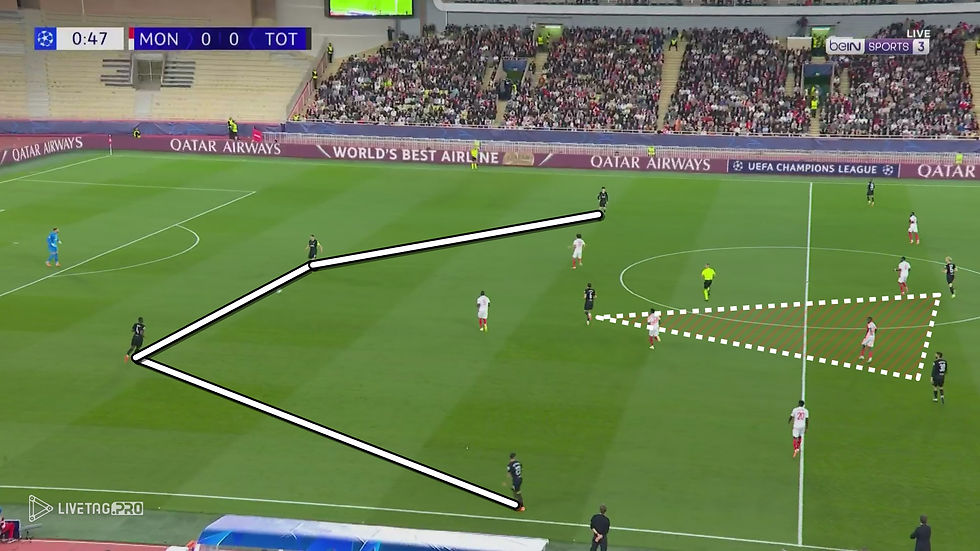
As previously mentioned, at times Spurs would build-up with Palhinha as the single pivot, with Bergvall and Bentancur pushing on. This was usually the case when Tottenham had the ball in their defensive third from a non-goal-kick situation.

During goal-kicks, or times when Vicario had the ball, Bentancur would sometimes start a little higher, but then drop alongside Palhinha to pick up the ball, or at least act like he’s coming to receive.
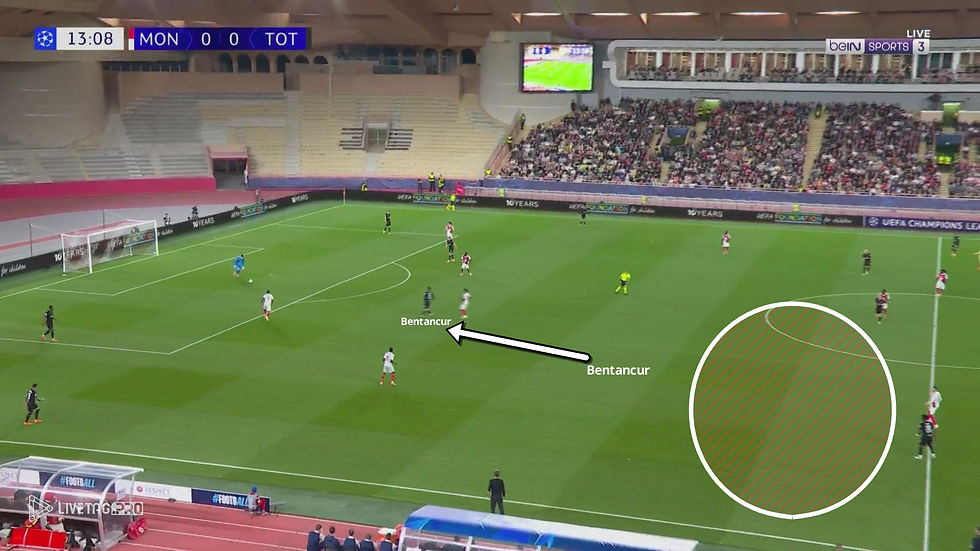
Due to Monaco’s man-to-man press, Bentancur dropping deeper would create space between Monaco’s midfield and defence, which then led to Vicario playing direct. This was Tottenham’s main method of build-up throughout the game, but it was quite easy for Monaco to deal with. Frank playing this way heavily relies on the forwards to win the duel, bring the ball under control, and bring others into play. If the duel is lost, you will almost always lose possession, as Spurs don’t have nearly enough bodies to pick up the second balls, with Palhinha and Bentancur so deep.


After Spurs had gone long, the ball, if they are lucky, drops to the feet of one of their forwards, but Bergvall is surrounded by Monaco midfielders, and you’re really just hoping and praying someone can get it under control and find a team-mate. Spurs didn’t overload these areas and look to pick up the second balls, often leading to turnovers.
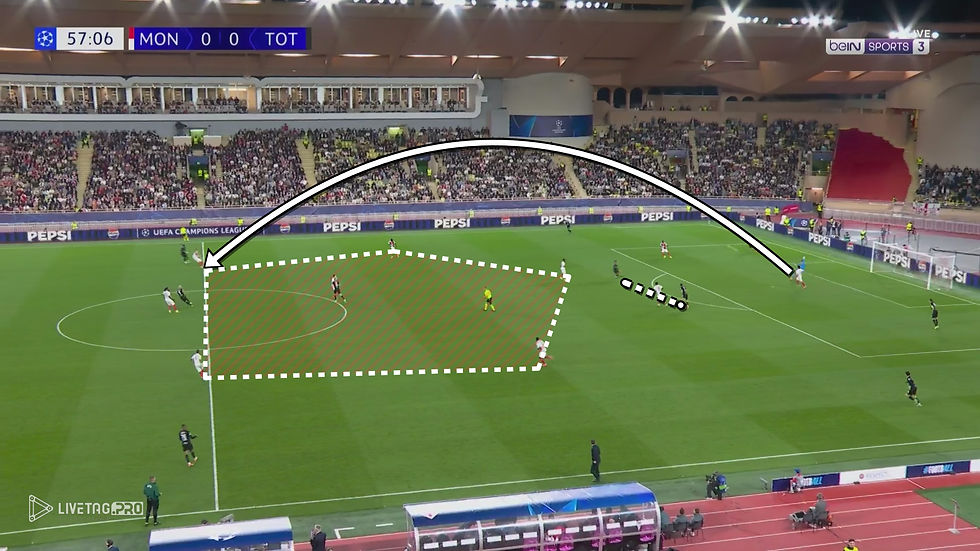
After the break, I was expecting a change from Spurs with their build-up, but the same, unsuccessful route of going long, usually to Kudus, appeared to be the game plan. Again, the if the ball somehow drops to Bergvall, he’s only surrounded by Monaco players and will struggle to produce a positive action from there.

On the odd occasion Spurs did play short from their build-up, they had some success. A simple pass into the feet of Bentancur who has made a short, sharp run to pull away from the man-to-man press, and he can quickly find Kevin Danso who has space to run into.

With Monaco pressing high, Bentancur can then look to run into the space vacated and pick up the ball from Danso, and all of a sudden he has an opportunity to carry the ball forward. It begs the unanswerable question - why didn’t they do this more often?
Out of possession

Out of possession, Spurs generally pressed in a 4-4-2, going man-to-man, more strictly in central areas. This often left gaps in behind their midfield two, who pressed on to the double pivot of Monaco, and it’s an area the opposition looked to exploit by dropping their forwards to receive between the lines.
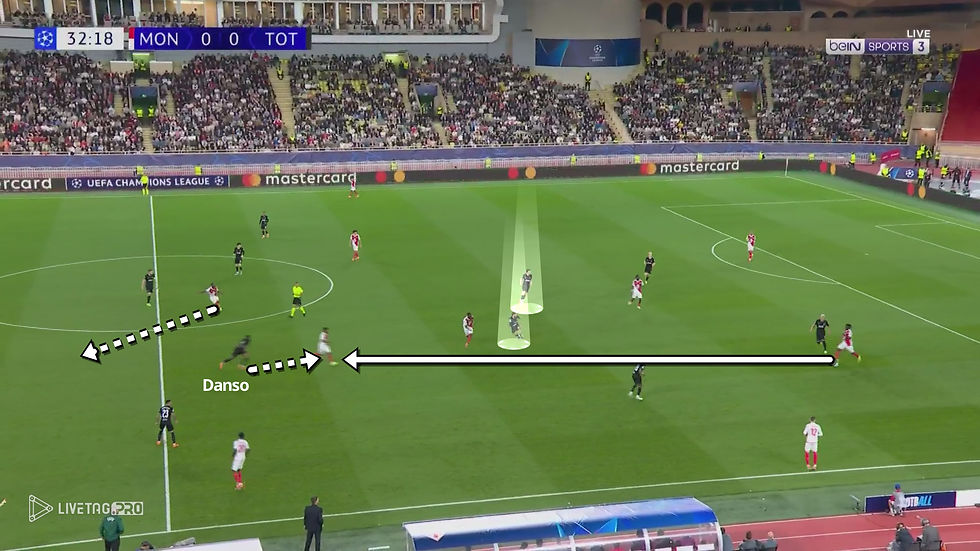
With Palhinha and Bentancur pressing the double pivot, Monaco were able to break lines into their attacking players, who dropped off from Spurs’ defenders. Danso often jumped to press the Monaco defender, which left an area for a Monaco attacker to exploit.
Spurs’ man-to-man press was easily bypassed by Monaco, who looked to counteract it by having attackers drop into the space, unlike Spurs who instead went direct to bypass the press.

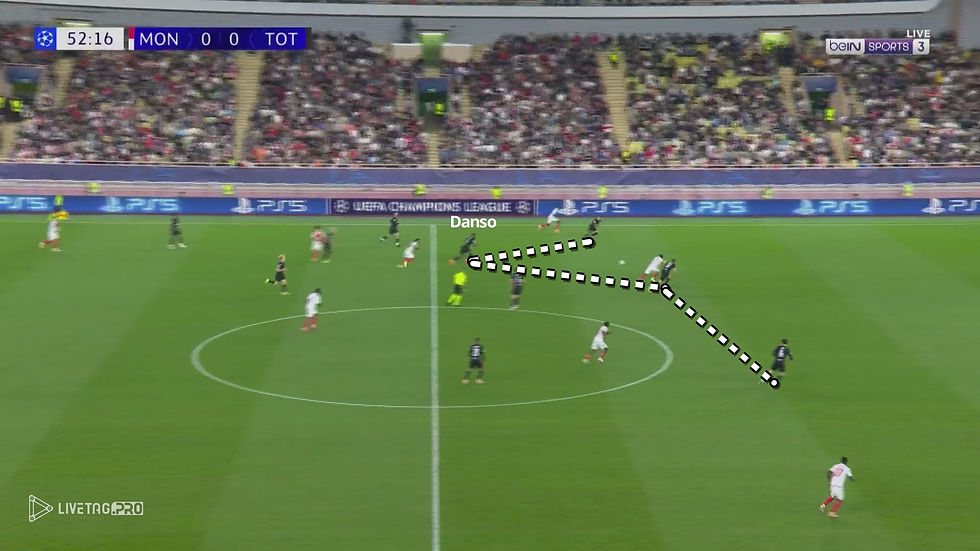
On multiple occasions, Danso would jump out of the defensive line to press the attacker who had moved to receive the ball. Again, Monaco would then look to play the ball in behind, targeting the space vacated by Danso. Whether it was an instruction for Danso to jump is unclear, but he would have likely felt forced to because Palhinha and Bentancur were pressing high up the pitch.
In-possession and chance creation

When Spurs reached the Monaco half, they wouldn’t look to progress the ball through the centre of the pitch. Bergvall and Bentancur would often look to push on to the Monaco defensive line when Tottenham looked to shift the ball out wide, with their main method of creating chances being putting the ball into the box from wide areas.

They’d almost create a front four after they’d gone out wide, with Porro and Gray regularly trying to get the ball into the box at every opportunity. There were instances were the likes of Bentancur would be trying to get on the ball between the lines, but the full-backs were clearly under instruction to cross from wide and deep.

As you’ll see above, a large portion of Monaco’s chances created came from central areas, whereas Tottenham struggled to make things happen. Spurs almost completely avoided trying to progress the ball into central areas and between the lines, even when Xavi Simons came off the bench.

Rather than looking to get Simons on the ball in and around the box where he can make things happen, he filled the box, alongside the rest of Spurs’ attackers, as soon as they got into the final third.
It was an effective method for Frank during his time at Brentford, but this Tottenham squad has a lot more quality, he’s just struggling to get the best out of them at the moment due to the style of play.

Plenty of times when the ball went wide, I was waiting for an attacking player to try and escape their marker and receive the ball, but instead they were regularly queuing up for a cross. The off-the-ball movement from Spurs’ attacking players was a bit of a concern, and they struggled to create chances as a result.
Monaco give Tottenham a lesson in final-third patterns

When Monaco got into the final third, it was a completely different story. When Caio Henrique, who played as a left-back in possession, received the ball, similar to where we regularly saw Gray and Porro receive it, he had options to play centrally, with the Monaco attackers rotating to escape markers and create space.

One and two-touch football dragged defenders out of shape, and Henrique (LB) showed a willingness to get into the box after finding a team-mate centrally. Rather than getting the ball out wide and delivering crossed to Danso and Van de Ven, who are excellent box defenders, Monaco tried to open them up centrally.
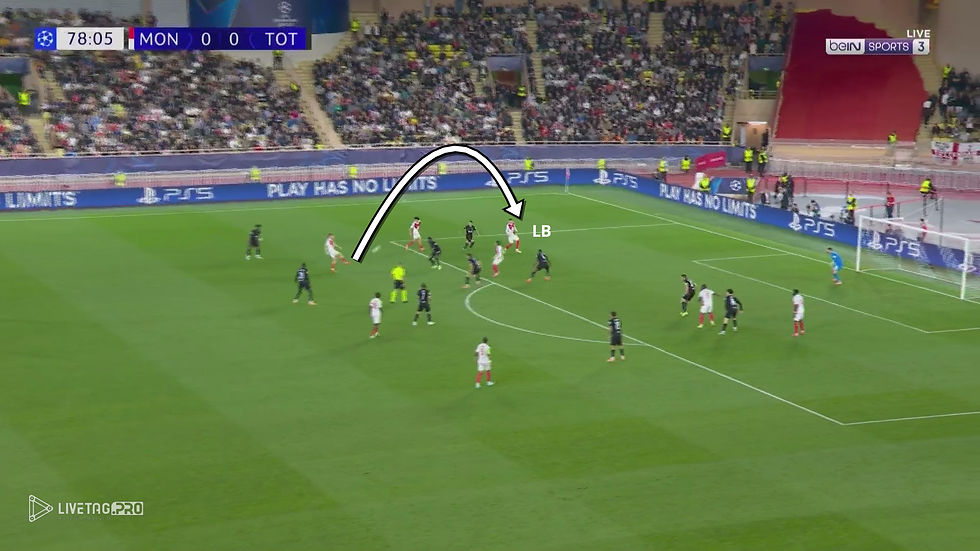
A couple of simple passes and movement, and they are able to get in behind the Tottenham defence to create a chance, teaching Tottenham a lesson in how to build patterns of play in the final third.
Conclusion
There are certainly concerns with Frank’s system at Tottenham at the moment. The man-to-man press was easily exploited through forwards dropping off the defensive line, their build-up play was almost non-existent, and their directness relied on many variables to actually turn defence into attack.
It’s no surprise that Tottenham are second in the Premier League for crosses this season, and although it can be an effective method of chance creation, Spurs have too much quality to rely on this so heavily.
There have been many complaints about the double pivot of Bentancur and Palhinha, but it seems it’s more of a systematic issue rather than the players.
Are You a Football Coach or Analyst?
Checkout The X-Planner - A versatile tool for coaches and analysts, built with a universal layout that adapts to any purpose - from planning sessions and analysing matches to tracking ideas and notes. Its flexible design makes it perfect for staying organised and efficient throughout the season.

.png)



Comments